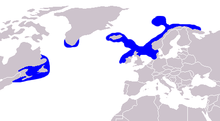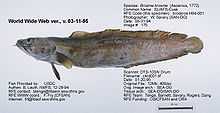Cusk (fish)
| Cusk | |
|---|---|
 | |
| Scientific classification | |
| Kingdom: | Animalia |
| Phylum: | Chordata |
| Class: | Actinopterygii |
| Order: | Gadiformes |
| Family: | Lotidae |
| Genus: | Brosme Oken (ex Cuvier) , 1817 |
| Species: | B. brosme |
| Binomial name | |
| Brosme brosme (Ascanius, 1772) | |

The cusk or tusk, Brosme brosme, is a marine cod-like fish in the ling family Lotidae. It is the only species in the genus Brosme.[1] Other common names include brismak, brosmius, torsk and moonfish.[2]
Description
It is easily distinguished at a glance from other cod-like fish as it has only one dorsal fin. Also characteristic is the nature of the dorsal, caudal, and anal fins, they are continuous at the base but separated by very deep notches so that they are obviously distinct. Moreover, the caudal fin is evenly rounded. It is variable in color, from slate to reddish brown above, and paling to gray on the lower sides and underneath. Older fish are usually plain colored, while the young often have transverse yellow bands on the sides. The maximum length is about 4 feet (120 cm) and top weight about 45 pounds (20 kg). IGFA world record stands at 37 pounds 14 oz (17,20 kg) caught by Anders Jonasson outside Sørøya in Northern Norway.
Distribution and habitat

It is distributed on both sides of the North Atlantic, mostly in moderately deep water. On the North American coast it is regularly found southward to Cape Cod and occasionally off New Jersey. Its maximum range covers most of the North Atlantic, including the waters around Iceland and the Norwegian coast.[1] It is also found on the Mid-Atlantic Ridge.[3]
Cusk shows little genetic differentiation over large distances, except where populations are surrounded by deep-water areas, namely on the Mid-Atlantic Ridge and the Rockall Bank. This suggests that deep-water areas are barriers for adult movements, and that, though tusk has pelagic eggs and larvae, dispersal during early life stages is not effective over long distances either.[3]
It is normally found in water deeper than sixty feet (20 m), and practically always is taken over rough bottoms where rocks, ledges, or gravel are common. Good fishing areas are usually much more limited than is the case with cod, haddock, or pollock. It is an offshore fish and rarely is one taken in a harbor.
Habits
It spawns in the spring and summer, usually between April and early July. A medium sized female has been known to produce more than two million buoyant eggs. The young live near the surface until they are about 2 inches (5 cm) long, and then seek out rocky ocean floors in deep water.
Food
It is strictly a bottom-dwelling species, and is sluggish and a rather weak swimmer. It eats crustaceans and other soft bodied invertebrates and mollusks.
Fishing technique

Cusk are primarily fished on the North American North Atlantic coastal shelf near the American state of Maine and the Canadian Maritimes.
In the Gulf of Maine, cusk are chiefly taken on hook and line. Line trawls account for most of the commercial catch off the New England coast, and most of them are caught during the winter and spring. The commercial catch individuals run between 1 and 2 feet long (30–60 cm), and average about 5 pounds (2 kg). It is an excellent food fish. It is marketed as fresh or frozen fillets; a part of the catch is smoked.

Conservation status
Fisheries and Oceans Canada (DFO) considers this species Endangered based on a 2012 Committee on the Status of Endangered Wildlife in Canada (COSEWIC) assessment.[4] The status report identified that catches of cusk in the DFO summer bottom trawl survey had declined by roughly 90% from 1970 to the late 1990s.[5] A landings limit of 1000 mt was put in place in 1999 in the 4X North American Fisheries Organization (NAFO) area and was further restricted to 750 t and expanded to include the 4VWX5Z NAFO areas in 2003. Cusk are still commonly caught as bycatch in the longline and lobster fisheries and can be found in supermarkets in Atlantic Canada despite its Threatened status.
Cusk is a U.S. National Marine Fisheries Service Species of Concern. Species of Concern are those species about which the U.S. Government’s National Oceanic and Atmospheric Administration, National Marine Fisheries Service, has some concerns regarding status and threats, but for which insufficient information is available to indicate a need to list the species under the U.S. Endangered Species Act(ESA).
References
- ↑ 1.0 1.1 Froese, Rainer and Pauly, Daniel, eds. (2006). "Brosme brosme" in FishBase. May 2006 version.
- ↑ Cusk Fish and seafood fact sheets. Agriculture and Agri-Food Canada
- ↑ 3.0 3.1 Knutsen, H.; Jorde, P. E.; Sannaes, H.; Hoelzel, R. A.; Bergstad, O. A.; Stefanni, S.; Johansen, T.; Stenseth, N. C. (2009). "Bathymetric barriers promoting genetic structure in the deepwater demersal fish tusk (Brosme brosme)". Molecular Ecology 18 (15): 3151–3162. doi:10.1111/j.1365-294X.2009.04253.x. PMID 19549108.
- ↑ COSEWIC Species Database: Cusk. [COSEWIC]]
- ↑ SARA registry report on Cusk (PDF) - Fisheries and Oceans Canada report on the state of cusk fisheries
- E. C. Raney "Cusk." The Wise Fishermen's Encyclopedia (1951)